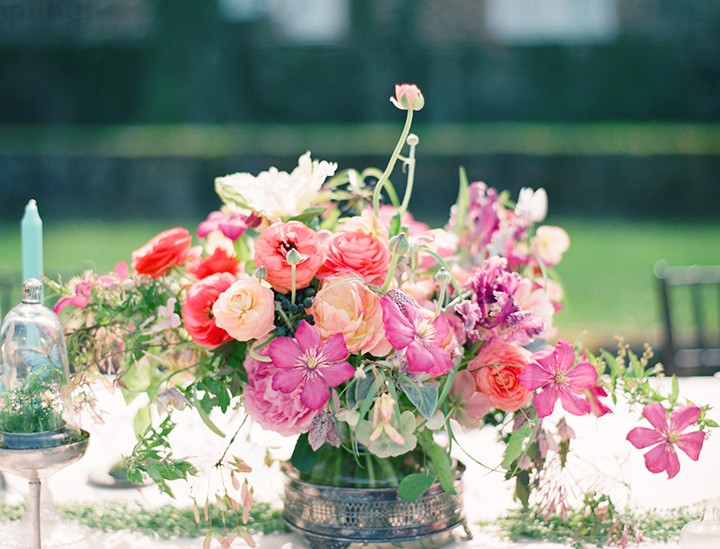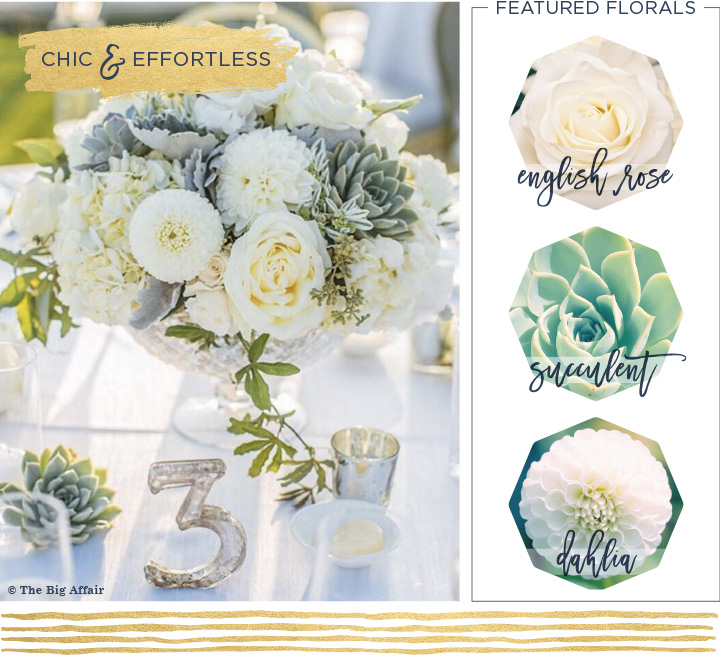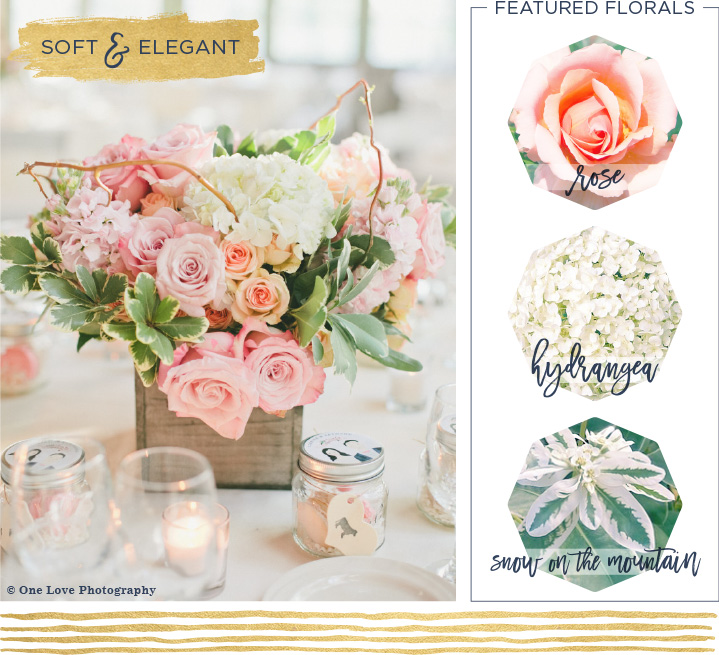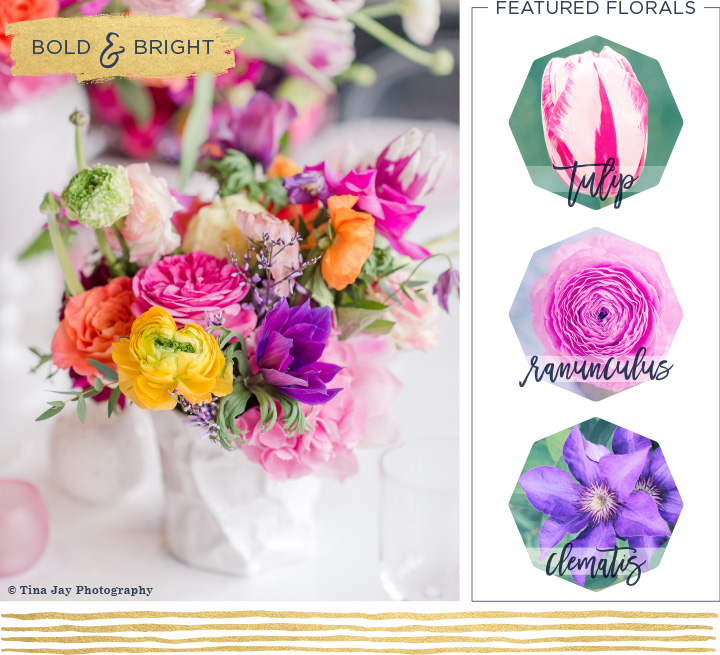Roses and peonies may be the most popular flowers for wedding centerpieces, but did you know that they pair well with exotic blooms such as protea and air plants? Whether you’re a seasoned florist, or a DIY bride, you can never run out of ideas for creative floral pairings.

Luckily, these 7 wedding centerpiece ideas, inspired by themed color palettes, will help you choose the perfect flowers and colors for your Lake Tahoe wedding. From stylish and feminine, to wild and rustic, we’ve included mood boards that feature the unique flowers that are included within each centerpiece so that you can easily recreate them. You’ll be sure to get inspired by these unique wedding centerpiece ideas and find a style that will suit the theme of your wedding!

This tablescape utilizes natural elements like geodes, quartz, and reclaimed wood, blending neutral colors with the soft pinks and greens of the centerpieces. These wedding centerpieces were designed by Arrangements Design and photographed by Katie McGihon. They consist of garden roses, protea, dusty miller, kangaroo paw, and air plants.
- Protea – Protea, also known as sugarbushes, are tropical flowers that are native to South Africa. There are over 2000 species of these flowers, which are known for their large, dome-like center with surrounding spiky, colorful petals.
- Kangaroo Paw – The fine hairs that surround kangaroo paw flowers give them their pollen-like appearance. These flowers are native to Africa, and they grow in a variety of colors including black, red, yellow, and orange.
- Air Plants – Air plants are great for warm weather weddings because they can withstand heat and do not need to be kept in water. Because of this they can easily be placed around the centerpieces or be incorporated into table settings as well.

This beautiful whites and succulents centerpiece came together nicely to grace the tables of a gorgeous outdoor spring wedding. The wide-lipped vase allows the lush flowers to showcase their natural volume and texture, creating a cylindrical centerpiece that mimics the the shape of the most prominent flowers — dahlias, lisianthus, and roses. The collaboration between photographer The Big Affair, event planner LVL Weddings, and floral designer Florals by Jenny really helped this wedding centerpiece compliment and enhance the clean tablescape. This centerpiece consists of English roses, succulents, dahlias, lisianthus, dusty miller, passion fruit vine, snow on the mountain, and eucalyptus.
- English Roses – English roses, also known as David Austin roses, are famous for their pleasant fragrance, repeat flowering capability, and wide range of colors. Their flowers have a cupped shape and many petals. They grow best in hardiness zones 5 through 10.
- Succulents – Succulents are available year-round, but are an especially good addition to warm weather weddings because they can stand heat well and won’t wilt. Their soft greens, blues, and greys are great accents to light-colored centerpieces like the one above.
- Dahlias – Dahlias can be used to add texture to a bouquet because of their many small, rounded petals. These flowers bloom in mid-summer, and will continue to bloom into the fall until the weather gets cold.
- Lisianthus – Lisianthus flowers are great for centerpieces because of their long lifespan as cut flowers — many can last in a vase for two to three weeks. Their loose, ruffled petals are a welcome contrast to more structured flowers like dahlias.
- Dusty Miller – Dusty miller can grow year-round in hardiness zones 7-10. It produces yellow flowers during the summer, though people are often most interested in its lacey, silvery foliage, which is commonly used in bouquets and centerpieces.
- Passion Fruit Vine – The passion fruit vine is a unique addition to the centerpiece above. It grows best in subtropical environments, and produces aromatic purple or yellow fruits. The vines grow quickly and should be guided along a fence or trestle.
- Eucalyptus – Eucalyptus’ long stems and many leaves are a great way to add depth to your centerpiece. The trees grow quickly, and are hardy and adaptive. Most species are evergreen, making them a good filler for bouquets and centerpieces year-round.

This rustic wedding used the deep purple and pink centerpieces to play up the natural brown tones of the table and gold accents of the glassware. The vases in varying heights gave the table some variation, while still keeping a consistent aesthetic. Each centerpiece was designed with care by Marie Floral Stylist and photographed by Gaile Deoso of Wanderlust Creatives. The centerpieces consist of carnations, spray roses, kale flower, eucalyptus, statice, veronicas, dianthus, and amaranthus.
- Carnations – Carnations are great flowers for centerpieces because of their long life as cut flowers, usually two to three weeks, and their vast color assortment. Red and pink carnations symbolize love and admiration, making them fitting for a wedding.
- Spray Roses – Spray roses usually have smaller blooms than typical roses, making them a good accent flower for centerpieces. Because they grow from small stems attached to one large stem, they’re often used for boutonnieres and corsages as well.
- Kale Flower – Ornamental kale plants, which cannot be eaten, are grown for the vivid color of their ruffled leaves. For optimal color, they must be grown in cool weather and kept well watered. They grow best in spring or fall in hardiness zones 2-11.
- Statice – Statice are used on both fresh and dried floral arrangements. They begin blooming in summer, and bloom into fall. Statice are relatively easy to grow because they are hardy plants that are drought tolerant and deer resistant.
- Veronicas – Veronicas are known for their narrow, spiky shape. They have a long bloom time — six to eight weeks — and bloom throughout the summer. They’re also known as speedwell, and known for their vivid blues and purples.
-
Green Trick
Dianthus – Green trick dianthus is a unique flower that has a fuzzy, globe-like appearance. It was bred in Japan, and is relatively new to the cut flower market, but works well in bouquets and centerpieces because of its long vase life. - Cascading Amaranthus – Amaranthus is known for its elegant appearance and vibrant color, which remains even when the plant is dried. It does best in warm weather and is drought tolerant.

This pink and white centerpiece adds a soft touch of color to the white tablescape. The low, wooden box allows the flowers to come to life, while subtly complementing the curly willow branches. This beautiful wedding was put together by Couture Events. The centerpiece was arranged by Stephanie Grace Design and captured by One Love Photography. It consists of hydrangeas, roses, curly willow, and snow on the mountain.
- Snow on the Mountain – Snow on the mountain is known for its showy leaves, which have white accents. The leaves are often used as fillers in centerpieces because of their unique appearance. This plant grows best in hardiness zones 3 through 9.
- Curly Willow – Curly willow, or corkscrew willow, is known for its curling branches, which are available year-round. These trees grow best in hardiness zones 4 through 8, and produce beautiful buds in the spring.

This summer brights wedding centerpiece steals the show, adding a welcome pop of color to the white tablescape. Foster’s Flower Shop strategically incorporates pinks, oranges, yellows, greens, and purples, to beautifully showcase the colors of the season. The centerpiece was perfectly captured by Tina Jay Photography, and is made up of hydrangea, garden roses, ginestra, anemone, ranunculus, tulips, clematis, and dahlia.
- Ranunculus – Ranunculus are popular for their bright blooms and delicate, layered petals. They do best in hardiness zones 8 to 10, and bloom in the summer. They’re great for adding texture to a bouquet or centerpiece, though they only last about a week as cut flowers.
- Tulips – Tulips are popular because of their unique shape and wide variety of colors, from bright reds and yellows to nearly black purples. They bloom from spring into early summer. Red tulips are great for weddings because they symbolize true love.
- Clematis – The Jackman clematis is the most popular type in North America. The flowers grow on a vine and bloom in mid to late summer. These purple blossoms do best in hardiness zones 4 to 8, and can grow in full sun to partial shade.
- Hydrangeas – Hydrangeas are great statement flowers because of their voluminous, round clusters of blooms. They bloom from summer into fall in shades of white, pink, purple, and blue. For some species, the color is determined by the pH of the soil.
- Garden roses – There are two types of garden roses — Modern Garden Roses and Old Garden Roses. Modern Garden Roses are the most common. They bloom continuously and have a long vase life, making them good for centerpieces.
- Ginestra – Ginestra are great accent flowers, because of their many tiny buds attached to a long stem. They are known for their strong, sweet fragrance and typically come in shades of pink, purple, yellow, and white.
- Anemone – There are many species of anemone, which are also known as windflowers. The fall blooming varieties are taller with cup-shaped blossoms, while the spring blooming varieties grow lower to the ground. They grow in a variety of colors including pink, red, purple, and white.
Blog Post in Collaboration with FTD




